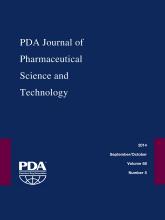Research ArticleResearch
Investigation of the Detection Ability of an Intrinsic Fluorescence-Based Bioaerosol Detection System for Heat-Stressed Bacteria
Kanami Irie, Allison Scott and Norio Hasegawa
PDA Journal of Pharmaceutical Science and Technology September 2014, 68 (5) 478-493; DOI: https://doi.org/10.5731/pdajpst.2014.01000
Kanami Irie
1Azbil Corporation, Kawana, Fujisawa-shi, Kanagawa, Japan; and
Allison Scott
2Azbil BioVigilant, Tucson, AZ, USA
Norio Hasegawa
1Azbil Corporation, Kawana, Fujisawa-shi, Kanagawa, Japan; and

References
- 1.↵
- Oliver J. D.
- 2.↵
- Oliver J. D.
- 3.↵
- 4.↵
- Gordon O.,
- Gray J. C.,
- Anders H.-J.,
- Staerk A.,
- Schlaefli O.,
- Neuhaus G.
- 5.↵
- Gray J. C.,
- Morandell D.,
- Gapp G.,
- Goff N. L.,
- Neuhaus G.,
- Staerk A.
- 6.↵
- Eaton T.,
- Wardle C.,
- Whyte W.
- 7.↵
- 8.↵
- Benson R. C.,
- Meyer R. A.,
- Zaruba M. E.,
- McKhann G. M.
- 9.↵
- Dalterio R. A.,
- Nelson W. H.,
- Britt D.,
- Sperry J. F.,
- Tanguay J. F.,
- Suib S. L.
- 10.↵
- 11.↵
- Pinnick R. G.,
- Hill S. C.,
- Nachman P.,
- Pendleton J. D.,
- Fernandez G. L.,
- Mayo M. W.,
- Bruno J. G.
- 12.↵
- 13.↵
- Pan Y.-L.,
- Boutou V.,
- Bottiger J. R.,
- Zhang S. S.,
- Wolf J.-P.,
- Chang R. K.
- 14.↵
- 15.↵
- Miller M. J.,
- Lindsay H.,
- Valverde-Ventura R.,
- O'Conner M. J.
- 16.↵
- Lee B. U.,
- Jung J. H.,
- Yun S. H.,
- Hwang G. B.,
- Bae G. N.
- 17.↵
- Kaliszewski M.,
- Trafny E. A.,
- Lewandowski R.,
- Wlodarski M.,
- Bombalska A.,
- Kopczynski K.,
- Antos-Bielska M.,
- Szpakowska M.,
- Mlynczak J.,
- Mularczyk-Oliwa M.,
- Kwasny M.
- 18.↵
USP <1223> Validation of Alternative Microbiological Methods. Pharmacopeial Forum, Vol. 33; United States Pharmacopeial Convention, Inc.: Rockville, MD, 2010.
- 19.↵
EP 5.1.6. Alternative Methods for Control of Microbiological Quality. European Pharmacopoeia, 2009.
- 20.↵
PDA Technical Report No. 33 (Revised 2013). Evaluation, Validation and Implementation of Alternative and Rapid Microbiological Methods.
- 21.↵
- Hurst A.
- 22.↵
- 23.↵
- Wesche A. M.,
- Gurtler J. B.,
- Marks B. P.,
- Ryser E. T.
- 24.↵
- Gray J. C.,
- Staerk A.,
- Berchtold M.,
- Hecker W.,
- Neuhaus G.,
- Wirth A.
- 25.↵
- Irie K.,
- Hasegawa N.
- 26.↵
- Irie K.,
- Hasegawa N.
- 27.↵
- Stephens P. J.,
- Joynson J. A.,
- Davies K. W.,
- Holbrook R.,
- Lappin-Scott H. M.,
- Humphrey T. J.
- 28.↵
- Takano M.,
- Tsuchido T.
- 29.↵
- Tsuchido T.,
- Koike T.,
- Takano M. A
- 30.↵
- 31.↵
Pharmaceutical Online. Instantaneously Detect Microbes: Validation testing of IMD-A® 300/350 Systems, Azbil BioVigilant, Inc., 2011. http://www.pharmaceuticalonline.com/doc/usp-ep-validation-testing-of-imda-systems-0001. Accessed November, 5, 2013.
- 32.↵
- Hasegawa N.,
- Yamasaki S.,
- Horiguchi Y.
- 33.↵
- 34.↵
- Heidelberg J. F.,
- Shahamat M.,
- Levin M.,
- Rahman I.,
- Stelma G.,
- Grim C.,
- Colwell R. R.
- 35.↵
- Buttner M. P.,
- Stetzenbach L. D.
- 36.↵
- Yao M.,
- Mainelis G.
- 37.↵
- Shintani H.,
- Sasaki K.,
- Kajiwara Y.,
- Itoh J.,
- Takahashi M.,
- Kokubo M.
- 38.↵
- Vorob'eva L. I.
- 39.↵
- 40.↵
- 41.↵
- Nudelman R.,
- Feay N.,
- Hirsch M.,
- Efrima S.,
- Bronk B.
- 42.↵
- Pellegrino P. M.,
- Fell N. F. Jr..,
- Gillespie J. B.
- 43.↵
- Kort R.,
- O'Brien A. C.,
- van Stokkum I. H. M.,
- Oomes S. J. C. M.,
- Crielaard W.,
- Hellingwerf K. J.,
- Brul S.
- 44.↵
- Irie K.,
- Hasegawa N.
In This Issue
PDA Journal of Pharmaceutical Science and Technology
Vol. 68, Issue 5
September/October 2014
Investigation of the Detection Ability of an Intrinsic Fluorescence-Based Bioaerosol Detection System for Heat-Stressed Bacteria
Kanami Irie, Allison Scott, Norio Hasegawa
PDA Journal of Pharmaceutical Science and Technology Sep 2014, 68 (5) 478-493; DOI: 10.5731/pdajpst.2014.01000
Jump to section
Related Articles
- No related articles found.
Cited By...
- Challenges Encountered in the Implementation of Bio-Fluorescent Particle Counting Systems as a Routine Microbial Monitoring Tool
- Clinical Data on Hospital Environmental Hygiene Monitoring and Medical Staff Protection during the Coronavirus Disease 2019 Outbreak
- Validation of Milliflex(R) Quantum for Bioburden Testing of Pharmaceutical Products





